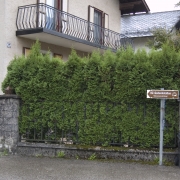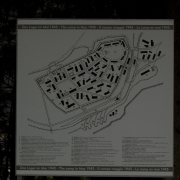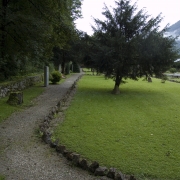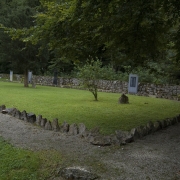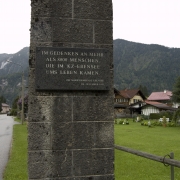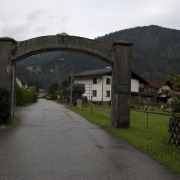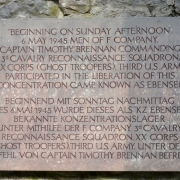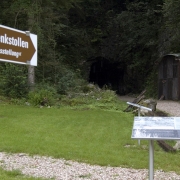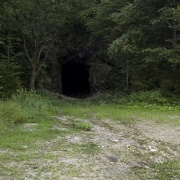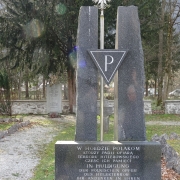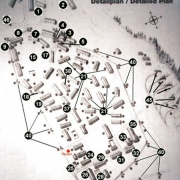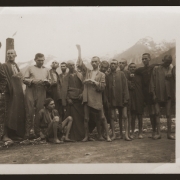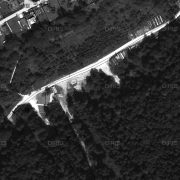Satellite Camp Ebensee
Gründung des Konzentrationslagers
Ebensee Subcamp was established on 18 November 1943. A tunnel network was to be dug in the mountains around Ebensee to provide safety from air raids for the missile testing facility run by the Heereswaffenamt (German Army Weapons Agency) out of the town of Peenemünde in Northern Germany. The prisoners had to dig two tunnel systems with a total area of more than 40,000 square metres. Other names used for Ebensee Subcamp: „Kalk“, „Solvay“, „Zement“, „Dachs II“ (code name for the lubrication oil refinery), „Taube I“ (code name for the crack plant).
Lokalisierung
The subcamp was in direct vicinity of the town of Ebensee. The initial plan was the construction of a huge tunnel system as well as the development of the anti-aircraft missile “Wasserfall” and the so-called “Amerikarakete”. The missile research centre should have been relocated from Peenemünde to Ebensee, a plan that eventually failed in late 1944. Tunnel system “A”, where crude oil distillation started in February 1945, was almost completed by the time the war ended, and system “B” was 60% completed.
Informationen über die Häftlinge
The majority of the prisoners of Ebensee Subcamp had been transferred over from Mauthausen. The first big transport of prisoners from Mauthausen Concentration Camp arrived in Ebensee only one day after the establishment of the camp. In total, about 27,000 prisoners were held captive at Ebensee. The highest number of prisoners present at the same time was 18,509, which was reached on 23 April 1945. As early as May 1944, 5,000 prisoners were held at Ebensee Subcamp; by the end of the year, it was over 9,000. Around 30% of the prisoners at Ebensee subcamp were Jews. Many the prisoners were from Poland, Russia, and Hungary.
Zwangsarbeit
Prisoners were assigned to work on digging the tunnels for the missile arming facility. The production of tank transmissions was planned to be carried out inside tunnel system “A”, the completion of which was the most advanced. The project was replaced with the set-up of an underground refinery though, as fuel production became a priority. In tunnel system “B”, the operation of a ball bearings production for Steyr-Daimler-Puch AG was underway. Prisoners had to work between eight and eleven hours every day without any safety precautions inside the tunnels. In the last days before the liberation, all prisoners in the tunnel systems were to be murdered. By refusing to enter the tunnel systems, the prisoners tried to thwart the murder attempt by the SS. The death rate for Ebensee Subcamp was at 31% - by the time of the liberation, more than 8,200 prisoners had died.
Bewachung
The prisoners in the labour detachment of Ebensee Subcamp were supervised by civilian workers. Camp leader SS-Hauptsturmführer (Chief Assault Leader) Georg Machmayer, SS-Hauptsturmführer Alfons Bentele, SS-Obersturmführer (Senior Assault Leader) Otto Riemer, and SS-Hauptsturmführer Anton Ganz stood out for their extreme cruelty and brutality.
Befreiung
Ebensee Subcamp was liberated on 6 May 1945 by the US Army (3rd Cavalry). Before the US Army arrived at Ebensee Subcamp, and the SS guards had been removed, approximately 52 prisoner functionaries, who had collaborated with the SS, were killed. Hundreds of prisoners died in the weeks after their liberation as a result of their imprisonment.
Gedenken und Erinnern
On the former grounds of the camp, a housing development was built after the war, and only part of it became a cemetery for the victims and the actual memorial site. The archway that was the main entrance to the camp can still be found at the entrance of the housing development. Today, there are numerous individual memorial plaques and official monuments on the cemetery, for most of the represented groups of prisoners. In 2011, a monument was erected showing all the names of the 8,412 victims on glass panels. In tunnel no. 5, an exhibition on the topic was launched in 1997, and since 2001, the Ebensee Museum for Contemporary History [1] has been providing information about the history of the camp. The date for the annual International Liberation Ceremony in Ebensee can be found here [2].





